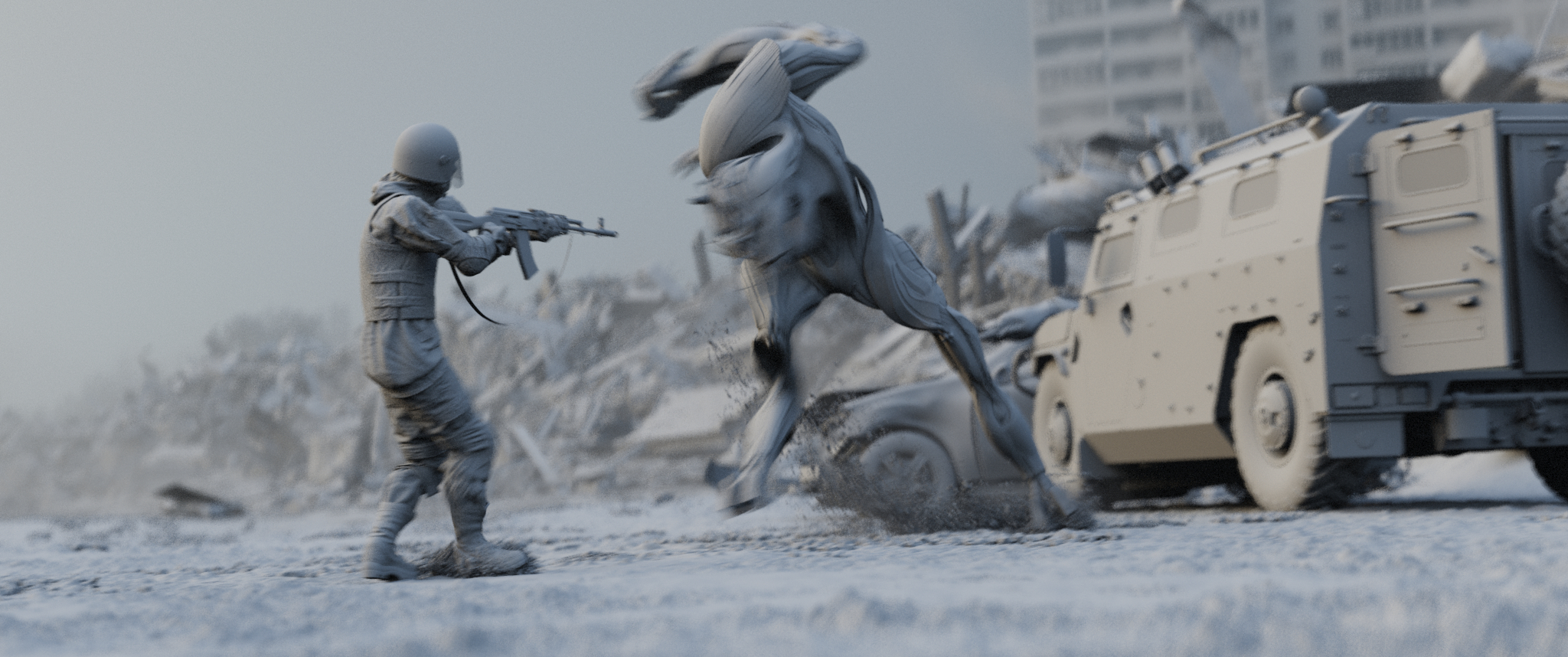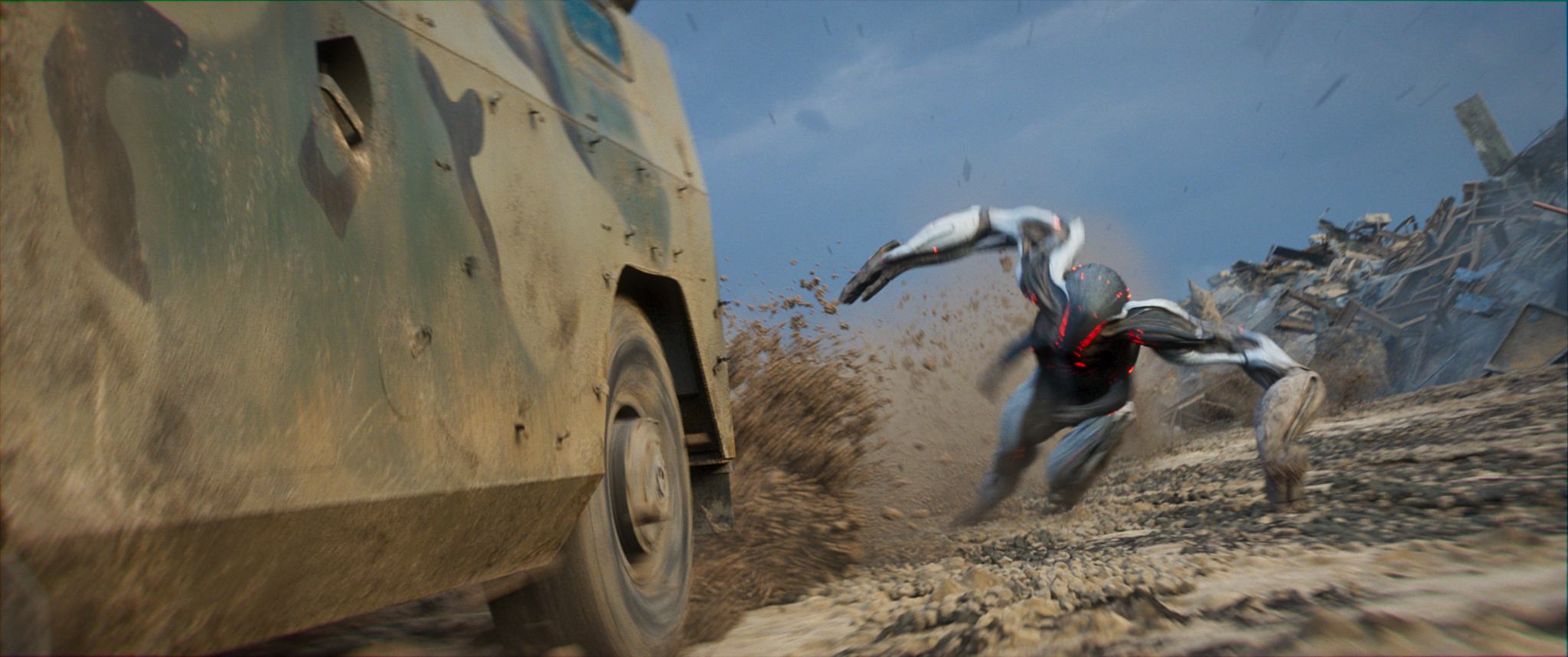There’s a lot of visual effects behind the scenes videos and making-ofs out there, so when one breaks through, you know it’s something special. Russian studio Main Road | Post’s VFX breakdown for its work on Fedor Bondarchuk’s Attraction, released earlier this year, certainly broke through, demonstrating the complex CG work behind the alien invasion film.
The video also showed off Main Road’s expertise in large scale animation and effects simulations, something they’ve been using Houdini to help produce since being founded in 2006. Other major Russian effects films the studio has worked on, including Stalingrad and Night Guards, have also made ample use of Houdini.
Members of Main Road Post’s team discuss how Houdini forms a major part of the studio’s pipeline, and how it was utilised for the stunning effects and animation for the alien ship, the alien creatures themselves, and a raft of explosions in Attraction, plus some of the mind-blowing effects work in Night Guards.
Main Road Post’s VFX breakdown for Attraction.
An Atom Ship
The alien ship seen in Attraction is an orb shape and based on an idea from the director that it appear like a model of an atom, complete with rings revolving around it. The ship has a ‘living’ feel to it, meaning it could slightly change shape. Its rings, too, had a kinematic sculpture-like appearance in that they had a solid external contour and a large set of small similar parts in its inner contour.
“Houdini’s proceduralism greatly helped us in achieving these kinematic sculpture effects,” notes Main Road visual effects supervisor Andrey Maximov. “The internal parts are moving in waves with a slight offset relative to each other in opposite phases, which creates a very interesting visual effect.”

The CG ship design.
A group of jet fighters attack the ship above a city. An interesting approach to the airborne surroundings that Main Road took, again aided by Houdini, was to create a single physically correct environment with everything derivative of the position of the sun. The team also created a basic model of cumulus clouds in Houdini, simulating air flows in the same way that occurs when clouds form.
“Another important aspect of clouds to be believable was their shading,” adds Main Road CTO Mikhail Lesin. “We did some research of how light behaves in the clouds, then implemented custom phase function for MIE scattering and found a way to render it with multiple scattering in a reasonable time. Using all of this, we made a library of believable looking clouds.”

Jet fighters attack the alien ship amongst the clouds.
Interestingly, the jet fighter scenes are punctuated with views from the cockpit - which were actually fully CG, including the pilot. “We are frequently asked why we did it in CG rather than shoot it on green screen,” says Lesin. “The answer is in lighting. It’s not that easy to recreate lighting you see in a sky on a shooting stage. When plane moves and changes its direction, all the lighting inside a plane changes dramatically and extremely fast. Since we didn't need too much pilot’s acting in these scenes, it was much easier to make the pilot a CG character than building a highly flexible motorized gimbal of cockpit just for a few shots.”


The CG fighter pilot.
The City Below
In the path of the alien ship is a city setting that would eventually be crashed into. That meant that it needed to be a digital asset, and it was here again that Main Road used Houdini and the studio’s own proprietary toolkit to procedurally generate districts of the city.
“The toolkit,” explains Houdini FX TD Igor Kharitonov, “includes a generator of residential buildings, urban infrastructure generator - trees, shrubs, lawns, parked cars, sidewalks, fences, lights, road signs, traffic lights, kiosks, billboards, communication wires between buildings, dumpsters and more - as well as a traffic simulation system that operated based on the basic principles of traffic on the streets of the city.”

The alien ship descends into the city in a fiery crash.
The traffic simulation component allowed artists to establish driving paths and simulate vehicle movement quickly. An artist would draw road paths via simple splines and then convert them to an arbitrary number of road lines, be able to connect them to cross-roads and scatter and simulate vehicles.
A custom solver, created with the VEX expression language in Houdini, made this possible, as Kharitonov details. “The solver utilises intelligent driver model to force vehicles maintain proper speed and distance between each other. Furthermore, additional features were implemented, such as traffic light control, giving preference on the unregulated crossroads, line change and others.”
Crash and Burn
The alien ship is brought down in a fiery mess, and it was one of the most challenging effects simulations Main Road had to carry out for the film. Extensive planning and previs was involved in working out where the ship would fly, how fast and over what area it would come down - this drove the design of the fall area and the infrastructure that would have to be (digitally) built around it. Houdini played a big role in the crash simulations.

The alien ship causes massive destruction as it crash-lands.
“After the approval of the previs by the director,” outlines Maximov, “we started working on simulations. Basically in the scenes you can distinguish two main groups of effects, rigid body simulations and fluid simulations. To work with RBD, all buildings, as well as the stadium, were made in accordance with the requirements for geometry imposed by such solvers as Bullet. Moreover, residential buildings also have an internal layout and staircases. In fact, any building in this film could be destroyed, since the procedural generator of buildings was originally made with this in mind. This gave us the opportunity even at the stage of finalizing the simulation of the destruction of houses to change their storeys and the configuration of entrances thereby varying the scale of destruction.”
The stadium, buildings and highway were destroyed with the Bullet solver in Houdini. A significant complication in this task was that the ship has a one-way collision interaction with other objects in the simulation. That meant the ship destroys buildings, but the buildings do not affect the ship in any way. “There were unrealistic accelerations of objects that do not occur in real life,” says Maximov. “Any material, and even more so, structure, possesses plasticity that deforms and breaks down the initial impulse. In order to achieve a balance in the behaviour of the debris, a number of ‘soft’ acceleration limiters were added.”

A huge of amount of smoke, dust and debris was simulated.
Extra components to the crash scenes involved dust, smoke and fine particulates launched into the air. For this, fluid simulations were used. A final effect involved a pyroclastic cloud of dense dust caused by contact with the ground and with the collapsing stadium and burning elements of the ship’s hull.
Aliens Attack
The emergence of the aliens brought new challenges for Main Road. Using approved sketches, artists created a model that represented the ‘exoskeleton’ design, building in muscles and bones. They then did a series of deformation tests before rigging commenced. This involved three modules, an animation rig, a deformation rig and the shading asset.


The gray shaded render and final images reveal how much of the environment and props and alien was computer generated.
Animation was carried out outside of Houdini, but then brought back into the package to deform the skin of the characters. “The deformation rig was designed for high poly deformation geometry of the exoskeleton and outputting caches ready for the final rendering,” says Maximov. “This rig was based on a muscle framework, which we developed inside the company. One of the key features of this framework is the muscle softbody dynamics that we used in most of the shots.”
Main Road’s shading asset was responsible for rendering the exoskeleton - something carried out in Houdini’s Mantra. “Input data for the shading asset were cache files generated by the deformation rig,” explains Maximov. “Shading was created in black and white. The idea was that a white exoskeleton is the only one and is controlled by a man, while a black exoskeleton is a robot controlled remotely by the artificial intelligence of the ship. In addition, we could regulate the degree of ‘dirt’ on the surface of the exoskeleton. Since quite a large part of the film occurs in the zone of destruction after the ship falls, all surfaces are covered with dust, ash, debris and dirt.”


A History of Houdini
As noted, Attraction is certainly not the first Main Road Post project to rely on Houdini. Significant work in the software was also done for the 2016 release, Night Guards, directed by Emilis Velyvis. Here, fully-CG characters were rigged, animated, shaded, lit and rendered in Houdini - as well as transformed into creatures, re-generated and destroyed with disintegration effects.
The VFX breakdown for Night Guards.
One transformation sequence involved turning a character into a hairy boar. “First of all,” outlines visual effects supervisor Alexander Lipilin, “a complete character digital double was created. Our internal human rig was modified for the animators to be able to break body parts apart, animate them separately and change bone length on the go. FEM simulation with animated rest geometry was used for blobs of fat that erupted on a character’s body. Tearing cloth was made with grain solver. And the final look of the boar’s fur was done with customizing default fur setup with VEX operators.”


Breakdown images from the transformation sequence.
A regeneration effect created for the vampire prince Yankul in the film involved a fully digital head tracked to the on-set actor’s performance. “For the character to look trustworthy on close-up shots alongside, a lot of detail was added in shading and grooming the asset,” says Lipilin. “Clotted hair with rotted wooden chips in it was done with lots of VEX, and over a million little tetrahedrons were scattered over the skin to imitate dust. The regeneration effect was done with several blendshapes with complex transition between them, whose bubbling edges was done with DOPs, SOPs and shading, and a lot of precise compositing afterwards.”
Chaos and Clarity: Why Main Road Chooses Houdini
It’s clear with projects such as Attraction and Night Guards, Houdini offers Main Road Post a way to plan out and control many complex effects and characters. “It is a universal tool,” suggests Lesin. “It allows almost everything to be done in one package. Its concept of digital assets is unique and very powerful, allowing multiple people to work simultaneously on one scene, and its proceduralism allows us to be very flexible, allowing us to work on modelling, for example, of a character while at the same time we already animating, shading and rendering it.”
COMMENTS
Arthur_Ivanov 7 years, 5 months ago |
Finally!
Strob 7 years, 5 months ago |
Stunning!!!
silkey 7 years, 5 months ago |
Incredible, Houdini being used to full effect. Especially impressed with the effort put into the procedural city.
TorbenAndreasen 7 years, 5 months ago |
What movie is this from..
Evgeniy Kovalenkov 7 years, 5 months ago |
https://en.wikipedia.org/wiki/Attraction_(film)
brokenkeyframe 7 years, 5 months ago |
this is unbelievable!
LukeWolf 7 years, 5 months ago |
Totally amazing!
AlexanderWeide 7 years, 3 months ago |
The best VFX CGI work within the last 10 years. Awesome guys
Igor Kuchavo 6 years, 3 months ago |
Incredible works!
I'm inspired!
Que_Caldway3 5 years, 12 months ago |
I've been waiting for this one! Awesome Phenomenal job!
Jisung 2 years, 7 months ago |
The most curios thing is computer spec.
How on earth that possible simulating full scale?..
Please log in to leave a comment.